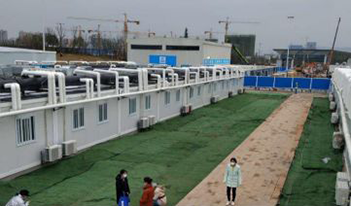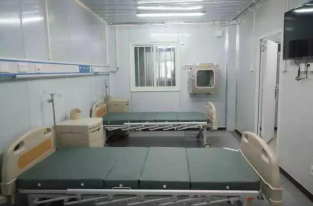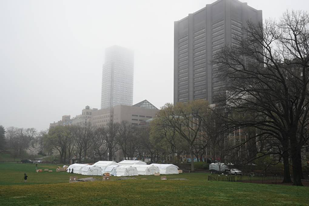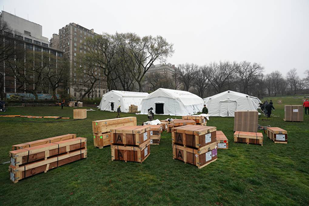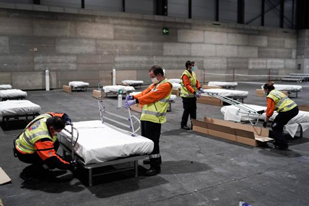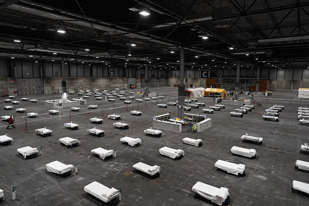Ventilation in mobile hospitals: international experience and ventilation solutions
Unfortunately, the problem of COVID-19 pandemic is still unresolved. The infection has spread throughout the world and as of today, there are already more than a million cases. Every day medical staff and professionals in other fields search for solutions for this problem, nevertheless the virus does not stop its spread and often hospitals are unable to provide medical care for all patients. In order to lessen the burden on medical institutions, many countries throughout the world have begun constructing mobile hospitals, and that is almost the most immediate solution for provision of medical care to coronavirus patients. The correctly designed ventilation in such hospitals does not allow for virus spreading outside and safeguards medical staff as well as ensures containment of virus and protects non-infected patients. In order to find the most efficient ways to fight COVID-19, we have analysed how mobile hospitals were constructed in different countries of the world, what types of such hospitals are there, and what are the peculiarities of ventilation in each of them.
In an effort to lessen the burden on healthcare system, different countries employ various methods of construction of mobile hospitals contingent upon their ability and convenience of medical care provision. However, each such hospital must have ventilation systems that primarily remove contaminated air from wards and ensure its decontamination. Such ventilation functions have direct effect on the safety of medical staff and patients inside of a hospital and prevent infection spread outside. In addition, having a healthy environment, where virus concentration is continuously decreased, the treatment of patients becomes more efficient, especially when their number may be as much as several thousands. As of date, most mobile hospitals may be divided into three types:
– Modular hospitals or panel-type hospitals.
– Field hospitals or tent hospitals (pneumo-framed modules).
– Temporary hospitals. Repurposed premises to suit medical needs: hotels, exhibition centres, etc.
Each such type has its own peculiar features of ventilation. However, taking into account the global scale of COVID-19 problem, it is important to find a solution, which would not only meet the requirement of a specific type of a mobile hospital, but would also be available anywhere in the world.
Vents, a Ukrainian company, is an international manufacturer of ventilation equipment. The products offered by the company are sold in more than 120 countries around the world and include the full range of ventilation systems equipment and accessories. In particular, one of the primary categories of Vents’ products is ventilation equipment for medical institutions.
Lifesaving construction set
Building of mobile hospitals of panel or modular type generally is the most time consuming. Nevertheless, organisation of ventilation in such hospitals is the most efficient because ventilation equipment and air ducts are installed at the stage of construction. Containers of Cura+ project created by an Italian architect Carlo Ratti for medical institutions outside Turin, Italy, may be included into this category. The idea was to use sea freight containers as an extension of hospitals. In the project designer’s opinion, it is an optimal option for suburban areas when it is necessary to create closed intensive care wards or general-purpose wards for patients in a few days period. According to Ratti, this saves time and efforts of people, who are tasked with deploying field hospitals. Another excellent example is panel-type mobile hospital Thunder Mountain in Wuhan, China. More detailed information on designing ventilation systems in this hospital we shall provide in our next article.
Mobile hospital in Wuhan
Ventilation system installed in panel or modular type hospitals must include separate units for forced removal of extracted air and supply of fresh air. Intake and exhaust ventilators are used individually for clean, partially contaminated and contaminated areas. In order to stop virus spreading inside a hospital and to avoid cross-contamination, it is important to prevent mixing of clean and contaminated airflows. For this purpose Vents manufactures intake and exhaust units and fans. Among those worth noting are duct fans KSV having thermal and sound isolation, speed and airflow control, as well as НЕРА filters for extra fine air purification.
The volume of intake and exhaust air must meet the requirements of each area in terms of pressure difference. Differential pressure setting is achieved according to directed airflow principle: clean area → partially contaminated area → contaminated area. A solution offered by Vents is to use air-distribution units for regulation of static pressure of KPR STP series for creation of VAV ventilation systems. They maintain reduced pressure in contaminated areas and increased pressure in clean ones, therefore ensuring airflow form clean areas into the contaminated and do not allow for backdraft.
Perhaps the most important aspect in ventilation of air in mobile hospitals is filtration and disinfection of air. For filtration of intake air, a three-stage filtration system with filters for primary (G2), fine (F7) and extra fine (H13) purification is used. In order to prevent infection spread into the surrounding environment, the filtration of exhaust air is performed through extra fine purification filters (H13). For such cases Vents recommends using filter-boxes FB K2, which are equipped with G4 filters for prefiltering, and F8 and HEPA filters of H13 class used for secondary filtering. The H13 filter delays up to 99 % of solid particles with a diameter of 2.5 microns, as well as fluff and bacteria. For additional removal of unwanted odours and gases, it is possible to install a carbon filter. Extra fine filtration is achieved through electrostatic filter, which is available in FB K2 ES modification. Each isolation room must have its own filter-box.
In addition, wards for treatment infectious diseases must have air-conditioning units. According to the Chinese design of mobile hospitals, cold and heat must be supplied by heat pumps of “air-air” type, and wards must be equipped with air-conditioning system using direct current electrical motors. Condensed moisture from the air-conditioning units must be centrally collected and disposed together with sewage waste from different areas.
Smoke exhaust systems are installed according to national standards applicable to infectious diseases hospitals, but taking into account the particular features of specific project of a mobile hospital.
Modular systems to the rescue
Pneumo-framed modules, which are also known as field hospitals or tent hospitals, have completely different particular features of controlled environment organisation. Structurally they are inflatable arch structures having a four-layer removable internal thermally insulated tent made from foil, thermally insulated floor, electrical equipment set, and a system for automatic pressure increase in the pneumatic frame. In order to install such a tent, air pumping is required. Electric power is supplied by a generator unit.
Connection of ventilation equipment is performed via special holes in the module. Air ducts are installed in those holes, and subsequently connected to ventilation equipment. It is important to ensure leak integrity of connections when installing air ducts.
Generally, field hospitals use inflow units with air heating during winter or air-conditioning equipment for air-cooling during summer as ventilation systems. However, in circumstances of infectious disease epidemics, instead of inflow units it is necessary to use exhaust units or fans with high-efficiency purification filters. Vents recommends radial inline fans VS with filter-boxes FB K2. Such equipment has high efficiency and low noise levels. Due to corrosion-resistant casing made from aluzinc, the fans may be installed outdoors, which is very important for field hospitals. Therefore, contaminated air will be removed from the premises and filtered, which in turn makes it safer for medical staff inside and prevents the virus from spreading to outside environment.
Fresh air is supplied to the tent naturally through windows covered with protective mesh screens. In order to ensure sterile environment inside pneumo-frame tents, disinfectant devices are used through which flows 100 % of air masses. Inside a device, an electrochemical treatment of air is performed in order to kill harmful bacteria and viruses.
Smoke exhaust systems in field hospitals are not provided for, however tent layers are treated with fire-resistant material.
The advantage of field hospitals is that they may be deployed in hard-to-reach areas or in immediate proximity to hospitals for quick patients’ redirection and provision of access to medicines or medical equipment. Such solution was adopted in the USA. In an effort to relieve pressure from the Mount Sinai Hospital, which is one of the primary medical institutions for admitting COVID-19 patients, a field hospital НВО Samaritan’s Purse was deployed in the Central Park of New York City. In deploying the hospital 70 persons were engaged, who completed the task in just 48 hours. The hospital is designed to host 68 beds, where 10 beds are for intensive care patients, and has 10 artificial lung ventilation apparatuses for the most severe cases. НВО Samaritan’s Purse will provide medical care for people with already diagnosed COVID-19. Similar field hospital, but smaller in scale, was deployed in Cremona, Italy.
Field hospital in New York
Time for transformations
Temporary hospitals are created by using premises of other buildings. For example, in order to lessen the burden on hospitals in Spain’s capital, an exhibition centre IFEMA was transformed into a hospital, which became the biggest one yet in Europe. It can host 5,500 patients. Hotels in Madrid are also repurposed as hospitals for treatment of light coronavirus cases. In total, hotels in Spain’s capital can provide approximately 60 thousand beds for COVID-19 patients. In Rotterdam, the Netherlands, multi-purpose arena Ahoy, where this year’s Eurovision was to be held, was transformed into a hospital. Temporary hospital is intended to hold 680 beds. In Germany, a centre for fighting coronavirus infection was opened on the country’s biggest stadium – Signal Iduna Park, which is the home to Borussia FC, Dortmund.
Temporary hospital in Madrid
Such objects have ventilation systems, including smoke exhaustion systems, installed at the stage of construction. Most commonly centralised intake-exhaust ventilation systems with heat recovery units and primary purification filters are utilized. However, considering the risk of mixing of airflows and low efficiency in air purification from viruses, they are not suitable for use in medical facilities, especially those that deal with infectious diseases. Therefore, even though ventilation systems are already in place, they must be retrofitted taking into account standards applicable to medical facilities and methods of infectious diseases containment.
In order for a temporary hospital to be efficient in treatment patients, all intake-exhaust units must be set to exhaust mode whenever possible. Having that in mind, air exhaust must be organised separately for clean and contaminated areas. In such a case, air intake will be made through a window, which in turn necessitates the use of disinfectant devices. For small premises (hotel suites), the most effective option is the use of indoor room ventilators set in intake mode. Vents offers single room air handing units of Micra series and TwinFresh ventilator series. They are easy and quick to install into the external walls, which allows for avoiding lasting renovation works. In addition, based on the requirements, the units may be set to air intake only or exhaust only operation mode. Moreover, they are equipped with automatics system and can have НЕРА filters of H13 air purification class. In order to ensure maximum level of sterile environment in the premises, it is important to use disinfectant devices.
Such facilities as hotels, exhibition centres and stadiums usually have easy access to ventilation equipment in order to ensure convenient maintenance procedures. This allows for easy replacement of primary purification filters with high-efficiency filters. As a solution, Vents again suggests our filter-boxes FB K2 equipped with G4, F8 and HEPA filters of H13 class, as well as FB K2 ES modification with electrostatic filter. When installing FB K2 filter-box, one must ensure that its dimensions fit the air ducts system’s dimensions in place at the facility.
In hotels, where each suite has an air-conditioning unit, it is important to organise condensed moisture collection and removal. Particular attention must be paid to leakage integrity of premises.
The whole world continues to fight COVID-19 pandemic. While scientists search for a vaccine against the infection, medical professionals are making their best efforts to help patients while also putting their own health at risk. According to the UN data, 20 % of the total cases in Italy are medical staff. In Spain, this percentage is 15 %. This means that hospitals are both battlegrounds and the biggest infection focal point at the same time. This is exactly why it is crucial to design correct ventilation during construction of mobile hospitals, because it has primary effect on whether virus will be isolated, as well as provides for safeguarding of medical staff and maintenance of healthy environment for patients. In order to help medical institutions in combating COVID-19, Vents offers its range of ventilation products.





